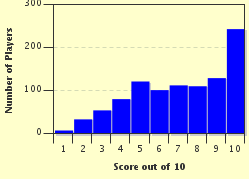Quiz Answer Key and Fun Facts
1. Which of these Central American countries does NOT share a border with Honduras?
2. Honduras includes a number of offshore islands as part of its territory. The department of Islas de la Bahia (Bay Islands) is made up of three large Caribbean islands along with an archipelago of smaller islets and keys. In this context, what is a key?
3. The Mesoamerican Barrier Reef, the second largest barrier reef in the world, has its southern end off the coast of Honduras. Divers there can see many interesting animals, including which of the following?
4. On his fourth voyage to the New World in 1502, Christopher Columbus reached the Bay Islands, and landed on the coast of Honduras near the modern town of Trujillo, capital of the department of Colon. What valuable resource was a major factor in inducing the Spanish to form settlements in Honduras, where they subsequently ruled for around three centuries?
5. Honduras has three distinct topological regions - two narrow coastal strips, and an interior mountainous region. Approximately what percentage of the country's area is in the central mountains?
6. The two highest peaks in Honduras are both located in the western part of the range. Which of these is the highest?
7. Honduras contains a number of significant rivers. Which of the following does NOT form a part of one of the country's borders?
8. Honduras contains a large undeveloped lowland jungle called La Mosquitia (on the Mosquito or Miskito Coast) in the southeastern department of Gracias a Dios. Here can be found part of a UNESCO world-heritage site which also extends up into the mountains along the Platano River. What is the name of this site?
9. In western Honduras, near the Guatemalan border, is the valuable archaeological site of Copan, remains of a city that flourished between 150 and 900 CE. What Pre-Columbian civilization had the capital city of one of its kingdoms there between 500 and 900 CE?
10. In 1998 Hurricane Mitch caused widespread damage in Honduras, especially in the capital city of Tegucigalpa. The storm stayed over the country for five days at the end of the rainy season, when the saturated ground could not absorb the heavy rainfall. What river overflowed, destroying several sections of the city?
Source: Author
looney_tunes
This quiz was reviewed by FunTrivia editor
Exit10 before going online.
Any errors found in FunTrivia content are routinely corrected through our feedback system.


